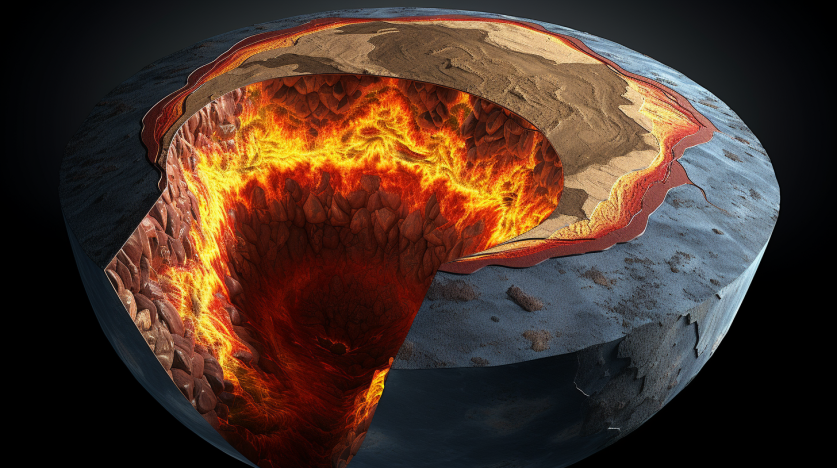What Is Inside the Earth?

Ever wondered what’s beneath your feet? In this article, you’ll discover the fascinating layers that make up our planet. From the crust’s rocky exterior to the core’s molten heart, you’ll delve deep into the earth’s interior.
You’ll also explore the methods scientists use to study these hidden depths. So buckle up, you’re about to embark on an extraordinary journey to the center of the Earth.
Unveiling the Layers of the Earth
Surprisingly, you’re about to delve into the fascinating complexity of the Earth’s layers. You’ll soon realize that understanding them isn’t just about geology – it’s crucial to comprehend Earth’s evolution.
Let’s start with plate tectonics, a pivotal process shaping our planet. It’s the movement, collision, and division of the Earth’s crust, resulting in continents shifting, mountains forming, and volcanoes erupting. These actions, spanning billions of years, have sculpted the Earth as you know it. They’ve also influenced the evolution of life, affecting habitats and climate.
The Crust: Earth’s Outer Skin
You’re standing on it every day, but have you ever wondered what makes up the Earth’s crust? This outer skin of our planet is more than just dirt and rocks. The crust composition is an intricate mix of elements and minerals.
First off, it’s primarily composed of oxygen and silicon. These elements combine to form silicate minerals, which make up about 95% of the crust.
Secondly, it’s broken into large pieces known as tectonic plates. These plates are constantly moving, albeit very slowly, causing earthquakes and volcanic activity.
Lastly, it’s the thinnest of Earth’s layers, varying from 5km to 70km thick.
Understanding the crust is key to studying the Earth’s surface and predicting geological events. So, next time you’re outdoors, remember there’s more beneath your feet than meets the eye!
The Mantle: A Closer Look at Earth’s Middle Layer
Diving beneath the crust, you’ll find the mantle, Earth’s middle layer, which is both vast and complex. This layer, composed primarily of silicate rocks rich in magnesium and iron, extends to a depth of nearly 1,800 miles.
It’s in the mantle where you’ll encounter a fascinating phenomenon known as mantle convection. This process, driven by heat from the Earth’s core, causes the rocks to move in slow, churning currents.
It’s critical to note that mantle convection doesn’t just shape the mantle’s structure; it’s also a key driver of seismic activities. Theses activities, in turn, give rise to earthquakes and volcanic eruptions.
The Core: The Heart of the Planet
Beneath the mantle, and at the very heart of our planet, you’ll find the core, a region as mysterious as it’s integral to Earth’s functionality. The core is crucial in many ways, and understanding it requires a close look at core formation theories and the core’s magnetic field.
Core formation theories suggest the core was formed from heavier elements sinking to the center during Earth’s formation.
The core’s magnetic field is produced by currents in the liquid outer core. This magnetic field shields us from harmful solar radiation.
The core is divided into two sections: the solid inner core and the liquid outer core. Each has unique properties and roles.
Understanding the core helps us grasp Earth’s complex geological processes and potential for life.
Studying the Earth’s Interior: Methods and Discoveries
In your exploration of Earth’s interior, you’ll encounter a variety of methods that scientists use to study it, and you’ll discover some of the fascinating findings that have emerged from this research.
A key method is seismic waves analysis. When earthquakes occur, they generate seismic waves that penetrate Earth’s layers. By studying how these waves change speed and direction, scientists can infer the types of materials present in the Earth’s interior.
Another crucial method is gravitational field studies. Earth’s gravity varies slightly across its surface, providing clues to the distribution of mass within. These studies have led to significant discoveries, such as the fact that Earth’s core is denser than its crust.
This analytical approach helps us understand the Earth’s inner complexities.
Frequently Asked Questions
How Does the Earth’s Interior Influence Its Magnetic Field?
The Earth’s core composition significantly impacts its magnetic field. You see, magnetic polar shifts can occur due to changes in the core. It’s these shifts that influence the Earth’s magnetic field strength and direction.
What Are the Effects of the Earth’s Interior on the Planet’s Climate?
You’re examining how Earth’s interior composition and core temperatures impact our planet’s climate. The heat from the core drives convection currents, influencing atmospheric conditions and ocean currents, which in turn affect our climate patterns.
How Does the Movement of Tectonic Plates Impact the Structure of the Earth’s Interior?
You’re examining how plate tectonics evolution and the continental drift theory influence our Earth’s interior structure. Tectonic movements shift Earth’s layers, causing seismic activity and reshaping the planet’s geological make-up over time.
What Are the Ongoing Researches or Studies About the Earth’s Interior?
You’re diving into research on interior exploration methods, probing Earth’s core mysteries. Scientists use seismic readings, magnetism studies, and simulated conditions to uncover the planet’s deepest secrets. It’s a thrilling, continually unfolding scientific endeavor!
Are There Any Potential Resources or Elements Inside the Earth That We Could Utilize in the Future?
Yes, deep drilling projects could potentially uncover valuable resources embedded in the Earth’s core composition. You’d be exploiting the untapped wealth of elements, potentially revolutionizing industries and enhancing our technological capabilities.



